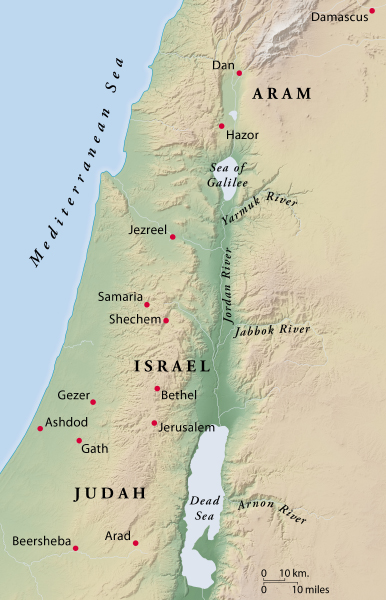Isaiah and Ahaz (7:1–9)
Aqueduct of the Upper Pool (7:3). The existence of an “upper” pool, apparently outside the city walls to the north, suggests a lower one, which is also mentioned by Isaiah (22:9), perhaps within the walls and thus more secure during siege conditions. The aqueduct apparently carried water to the upper pool. Water was a major problem for Jerusalem throughout her history, and identification of the various elements of her water system is a matter of some debate.242 It appears that the king is here inspecting the water supply of the city, which would soon be under siege.
Washerman’s Field (7:3). Washing and working new cloth is called “fulling,” which leads to many translations identifying this as the “Fuller’s Field.” It rid the material of natural oils before it could be used and was an important part of cloth preparation.243 The place where it was done seems well known, since it is the site of two important meetings (36:2; also 2 Kings 18:17).
Be careful (7:4). Lachish in Judah has produced several letters from the first quarter of the sixth century B.C. One says: “I am also sending to my lord the letter of Tobyahu, servant of the king, which came to Shallum son of Yada from the prophet and which says, ‘Beware.’ ”244 Exactly who is warning whom is unclear,245 but it appears to involve a confrontation between prophet and king, though in Isaiah the message is encouraging, which might not be the case in Lachish.

Parties in the Syro-Ephraimite War
Son of Tabeel (7:6). Two people are shown little respect, since only their father’s name is given. They are Pekah, simply called “son of Remaliah,” and another who is “son of Tabeel.” The name is Aramaic, so it may indicate someone who had pro-Aram/Syria sympathies, that is, who would oppose Judah and side with her enemies in this Syro-Ephraimite conflict.246 Another possibility is that it refers to Tubail/Etbaal, the king of Tyre who paid tribute to Assyria, along with Rezin, in about 738 B.C.247 One of the two enemies will take over Judah for himself.
Sovereign LORD (7:7). “Lord” (bēl) is a common descriptor of Mesopotamian gods,248 and a special name assumed by Marduk when he gained ascendancy over the other gods in the Enuma Elish creation epic.249 A common Semitic noun for “lord, ruler,” baʿal is the name of an important god at Ugarit,250 who is also well known in the Old Testament. The Phoenician god Melqart is also called “lord.”251 What should distinguish Yahweh from these other “lords” is that he is indeed sovereign.
Sixty-five years (7:8). This specific period of time is given as that in which Ephraim will become no more. Since the events of this story take place about 735 B.C., the period ends in 670 B.C., which is a puzzling figure since the Assyrians captured Israel’s capital, Samaria, and ended its monarchy fifteen years later in 722 B.C., with its people exiled and foreigners transplanted into its territory. The end of the reign of Esarhaddon and the start of that of Ashurbanipal took place about 669 B.C.

Captives from Syria in an Assyrian relief from Nineveh
Todd Bolen/www.BiblePlaces.com
Both of these kings engaged in exile and resettlement during their reigns. Esarhaddon says concerning a campaign against Sidon in Syria: “I drove to Assyria his teeming people which could not be counted,”252 while Ashurbanipal says much the same concerning his campaigns against Egypt and Tyre.253 He mentions receiving tribute, “ten minas of gold from the land of the Judeans,”254 but neither of them mentions taking exiles from Israel, though their records are far from complete.